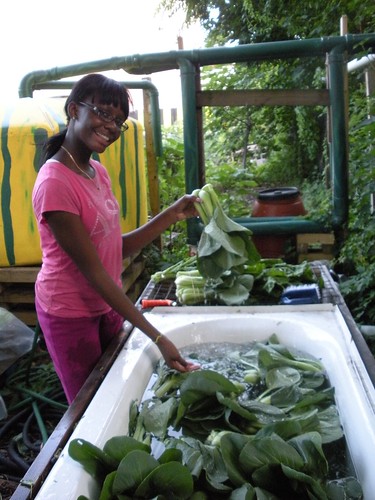
If your picture of New York City is skyscrapers and neon, consider expanding that image to include vegetable crops – a lot of vegetable crops – growing everywhere from ground level to rooftops.
The Big Apple boasts the largest community gardening program in the United States, bringing more local food into the city’s food system. Research by Forest Service scientists contributes to this effort, giving everyone from city managers to community organizers, farmers and gardeners information on how agriculture is impacting neighborhoods and the local food supply.
Lindsay Campbell, a research social scientist with the New York City Urban Field Station, a unit of the Forest Service’s Northern Research Station, has interviewed dozens of policymakers, nonprofit leaders and community residents engaging in urban agriculture.
Campbell’s research, part of her dissertation for her doctorate in geography, centers on the city’s long-term sustainability plan, or PlaNYC2030, and examines how the policies and practices of urban forestry and agriculture in New York City are negotiated.
Her work has unearthed additional opportunities for research on agriculture in the city.
In a project with the New York City Parks and Recreation Department’s GreenThumb program, Urban Field Station scientists are analyzing prior survey data and interviewing representatives of 102 community gardens for insight into the evolving role of New York City’s community gardens.
Forest Service research is also evaluating the effect that gardening has on the lives of the gardeners. NYC Urban Field Station scientists are helping assess the long-term effect that working in urban agriculture has had on alumni of the East New York Farms! youth internship program. East New York Farms! is a project of the United Community Centers and a recipient of a USDA Community Food Project grant.
In 2011, East New York Farms! and 35 urban gardeners grew more than 14,000 pounds of produce for local farmers markets. East New York Farms! also manages two urban farms and works with more than 80 gardeners representing two dozen community gardens and more than 20 backyard gardens.
You can read about research presented at the 2011 American Community Gardening Association conference in New York City by Forest Service scientists and many others in a special issue of the journal Cities and the Environment, which was co-edited by Forest Service research technician Nancy Falxa-Raymond.
To find community garden projects in both urban and rural areas that have received USDA support, search for gardens on the Know Your Farmer, Know Your Food (KYF) Compass map. The map is a project of the KYF initiative, a USDA-wide effort to strengthen the department’s work on local and regional food systems that connect rural and urban communities.
